Alison Denham - Taped Together - Almond Butter Toast
Saturday, February 02, 2008
Rosemary and I watched Alison Denham dance in Taped Together with a clear plastic raincoat last night at Dances for a Small Stage. She was terrific. The very special icing on the cake was that she replaced, at the very last moment, the intended Nureyev for Patrick Pennefather's The Deconstruction of the Dancer. It would seem that Nureyev declined at the last moment. And if that was not all we saw a bit more than twice performances by the exciting duo of Crystal Pite and Cori Caulfield in Farther Out There and Even Further Out There. Dave Brubeck would have been entranced.
The above performances coincided with the publishing of VLM's February issue containing what follows:

AB fab
Last December I watched a performance of Wei Dance's Three Sixty Five at the
East Vancouver Cultural Centre with my 10-year-old granddaughter. It featured six dancers including Wen Wei Wang. But my granddaughter singled out dancer Alison Denham and shouted into my ear, "Look at those abs!"
When I asked Sunshine Coast-born Denham, 29, if her body was due to genes or excercise (I have not seen any other dancer with a similar body), she answered, "Genes mixed perhaps with some excercise."
Denham started dancing recreationally when she was 10. When she was 12 she met retired National Ballet of Canada ballerina Lois Smith, who at the time was living in the Sunshine Coast, and for Denham it all changed. "Through her I saw how serious dance could be and how one could have a life at it. From then on I had classes with Smith every day. By age 14, when Denham finished a Royal Winnipeg Ballet summer program she knew dance was going to be her life. She pursued it at Arts Umbrella and the Ballet BC Mentor Program. She has performances for Judith Marcuse, Paras Terezakis, Judith Garay, Alvin Erasga Tolentino, Serge Bennathan and many others under her belt. She is part of Wen Wei Dance and of Company Erasga.
Suspecting that diet might have something to do with her strong physical condition I asked Denham what she eats on a normal day. "For breakfast I might have a cup of Orange Pekoe tea and toast with almond butter. For lunch it could be sushi, rice with kale, chicken or some meat product. For dinner I would have pesto pasta, avocados and a glass of wine."
After the performance of Three Sixty Five I asked Wen Wei Wang what role Denham played in his company. His answer was short, "She is my mother." Denham explained, "I don't know Wen Wei's mother but I think that he gives me roles that are based on emotion as opposed to physicality. In some way I seem to represent all women for him."
Alison Denham will be performing in May 2008 with the new modern dance company Move: The Company directed by Josh Beamish.
© 2008 VLM/Alex Waterhouse-Hayward
Deborah Does Not Endorse Gleem With GL-70
Friday, February 01, 2008
 It always comes as a shock when I travel to Latin America. In Argentina, four years ago I kept seeing an ad for toothpaste that featured a gorgeous Argentine woman in a bikini. In Mérida last year I was perplexed by huge beer ads similar to the one advertising Howard Hughes's The Outlaw with Jane Russell. The ad read something like, "Two good reasons to drink.....beer." 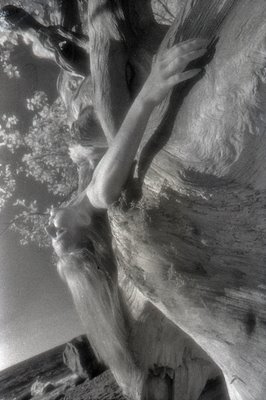 It comes as a shock because we now rarely take advantage of the female form to sell products in Canada. I could not explain our attitude to my Argentine relatives who kept suggesting we Canadians did not have a sense of fun or a passion for life. And when I remember my friend Juan Manuel Sanchez sketching one of our live nude models in my studio I think that the answer must lie somewhere in between. But what is one to do when the phone rings as it did some years ago and the very English Deborah, an acquaintance from my days at Wreck Beach said, "I need you to record my body before nature settles in." What do do? I always comply without feeling too guilty of any kind of exploitation. After all I am not selling the photographs and no product is being advertised. But I have a nagging suspicion that many years from now when some very different imaging technology will be reigning in society these b+w photographs will have their charm, a charm that they presently have for me. 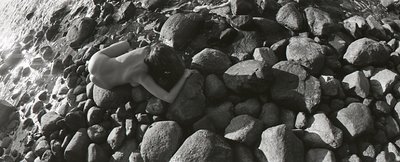
Lord Byron, Newstead Abbey, William Gibson The Count & The Countess of Lovelace
Thursday, January 31, 2008
...a straggling, gloomy, depressive, partially-inhabited place the Abbey was. Those rooms, however, which had been fitted up for residence were so comfortably appointed, glowing with crimson hangings and cheerful with capacious fires, that one soon lost the melancholy feeling of being domiciled in an extensive ruin.
William Harness a friend of George Gordon, Lord Byron
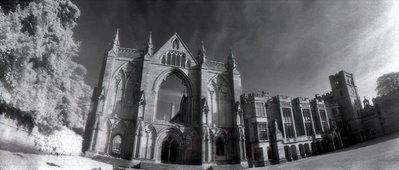
In March 1988 I photographed William Gibson in his home. Having just read his novel Count Zero I attempted to make Gibson look a cyberspace count, a Dracula with a remote.
In 1990 he co-wrote with Bruce Sterling my favourite Gibsonian novel, The Difference Engine. It is a "what if" novel in which real life early computer pioneer Charles Babbage perfects in 1855 a steam driven Analytic Engine. History and the British Empire are irrevocably altered.
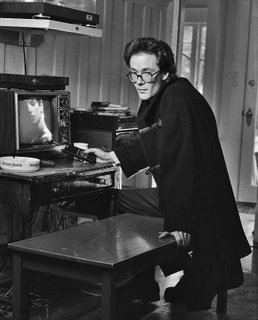
Somehow Lord Byron does not die young and is the Prime Minister, his mathematical genius daughter Ada lectures on some purported magical punch cards and their ability to solve Gödel's Theorem (in actual fact solved in 1931). An interesting character of the novel is Mori Arinori, Japan's first Ambassador to the United States who campaigns to abandon the Japanese language (including the written one) in favour of English so as to modernize Japan. Wellington is assasinated when he attempts to thwart the Difference Engine's rapid change of Victorian England. This is one of my favourite of all "what if" novels. It is as good as those other two, where Hitler wins the war, Philip K Dick's The Man in the High Castle , and Robert Harris's Fatherland (four-door VW Beetles and President Kennedy is not John F. But his father Joseph P.).
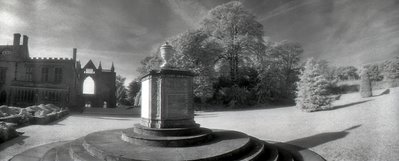
In the late 80s I went to Shropshire and visited Nottingham. I took a side trip to Newstead Abbey where Lord Byron lived for about a year where:
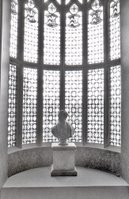 ...he and his university friends practised fencing, boxing and pistol shooting. From his student rooms at Trinity College he brought his gilded bed and a tame bear.
...he and his university friends practised fencing, boxing and pistol shooting. From his student rooms at Trinity College he brought his gilded bed and a tame bear.
The bear roamed the Abbey in the company of Byron's other pet animals, including several large dogs, tortoises and a wolf. The wine cellar was well-stocked with good claret and the library contained many fine books - for, Byron spent much of his time at Newstead reading and writing.
Newstead Abbey was a delight because it was not (and is not) a National Trust historical building or garden site. It is run by Nottinghamshire and this means fewer people. I arrived after spring so the extensive rhododendron collection had already bloomed. The inside of the living quarters were slightly gloomy in an "undead" way. I thought of vampires.
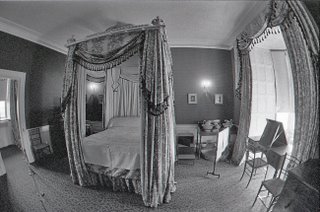
We know that the poet Percy Shelley, his young mistress, his sister Mary and Lord Byron spent time in 1816 in a house in the Italian side of Switzerland at the Villa Diodati. They dared each other to write a scary a novel. Byron began one on vampires but never finished it.
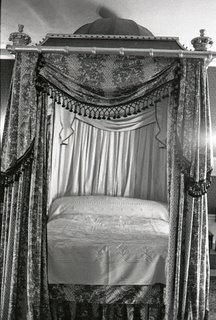
Only Mary Shelley delivered with Frankenstein. Byron's young doctor, John Polidori was also in attendance and three years later published Vampyre which was first attributed to Byron. This whole story of the summer at Villa Diodati is deftly novelized in another wonderful "what if" by Argentine Federico Andahazi in Las Piadosas. Just for once English readers can enjoy Alberto Manguel's translation The Merciful Women (2002). Vampires lurk at Villa Diodati and...
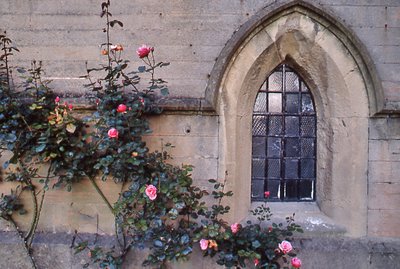
It was thus delightful to discover John Crowley's Lord Byron's Novel - The Evening Land as a hardcover at Chapters for $5.99. With my Chapters Reward card I was given an additional 10% discount.
This is a delightful "what if" novel in which Byron's daughter, Ada, Countess of Lovelace (who we know was into mathematics and learn here that she was a frind of Charles Babbage) discovers her father's (whom she never met) manuscript. Crawley's novel retells (publishes?) the long lost novel whose discovery is told by Ada who feels a longing for the father she never met. Meanwhile a young woman, and her father (who have a strained relationship) forward in the 20th century re-discover traces, but not the novel of the novel. Their relationship is restored through the adventures and in a way Ada finds Byron in the 20th century.
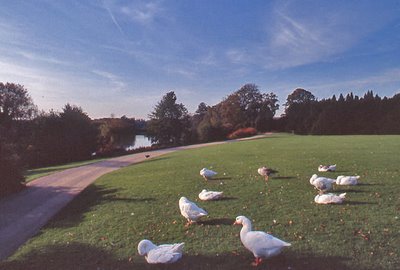
Of Newstead Abbey, Ada writes in Crowley's novel of the novel:
I had at that time reached what I may call an epoch in my feelings about my paternal ancestors. Not long before, my husband William, Lord Lovelace, and I accepted an invitation to visit Newstead, the ancestral seat of the Byrons in Notthinghamshire, now in the possession of Colonel Widman, once Lord Byron's schoolfellow at Harrow. There - amid scenes where the father I never knew was wont to roam and to make merry; where his forbears worthy and profilgate had lived, and whose incomes they had wasted, in former ages; where nearby stands the little parish church, in whose crypt my father lies with his people - I know not how, but all that I seemed once to have known concerning that troubled and tempestuous spirit, all that I had been taught to think about him - and to hold him guilty of - all vanished, or lifted as cloud; and I knew myself to be, with all my own faults, a Byron, too, as was he, with his: and if I could not love him without charges upon his soul, I could not love myself, or his grandchildren that were my children. In a letter that is quoted in the Life written by Mr. Thomas Moore, Lord Byron stated his belief that a woman cannot love a man for himself who does not love him for his crimes.
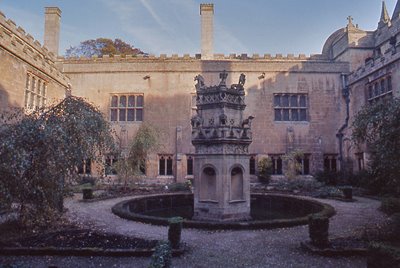
No other love says he is worthy the name. Whether or not my own soul is capable of so august an ideal of love, I hold it to be applicable as well to a daughter as to a spouse; and none my hinder me now from aspiring it.
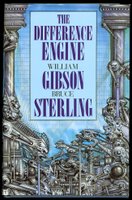 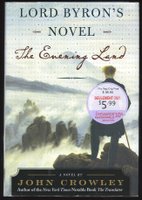 Another fave "What If" Another fave "What If"
An Australian Napoleon, Two Horatio Nelsons & Wellesley Is Impressed
Wednesday, January 30, 2008
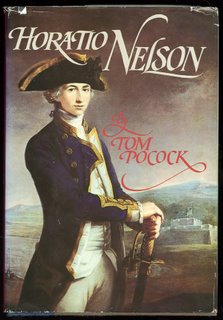 One of the richest experiences I can have is discovering a "new" author who has written over 20 novels. Years back Celia Duthie introduced me to Arthur W. Upfield mystery novels in which Detective-Inspector Australian half-breed Napoleon Bonaparte (" my friends call me Bony") solves murders in the Australian outback of the 1950s. It took me a while to find some of the out of print books in the author's series of about 28 novels. So much fun! I could read one after another. I remember going to listen to Patrick O'Brian lecture in Seattle. When I got back my friend Marv Newland asked me, "How did he look? Do you think he has another novel in him?" O'Brian died after almost finishing his 19th Captain Aubrey/Doctor Maturin novel. With English author Reginald Hill I read him almost as fast as he writes them. I just finished Death Comes For The Fat Man but I was elated today to find out he has written the next one in his Dalziel/Pascoe series, A Cure for all Diseases.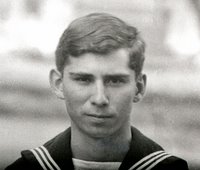 It is an equal pleasure to see a film I know I have seen before, but except for a few scenes it is all but forgotten. A couple of days ago I experienced that pleasure when Rosemary and I saw Vivien Leigh and Laurence Olivier in the 1941 That Hamilton Woman. This ostensibly British film was filmed in a Hollywood lot and it is full of innacuracies. In spite of them, it is a rowsing film full of delights. Of the innacuracies I know as I have read (over and over) one of the best Nelson biographies, Horatio Nelson by Tom Pocock (1987). In this biography I learned that Horatio Nelson was a true hero and nothing of his life needs to be enhanced. His only competition came from another English seaman Lord Cochran. There is a bit of both men, via Frederick Marryat's Mr. Midshipman Easy (1836), in Patrick O'Brian's Captain Jack Aubrey. In many of O'Brian's novels Jack Aubrey recounts being at the table with Nelson (when he, Aubrey was a young officer). Nelson asks Aubrey, ( "in a most natural way"), "Please pass the salt." It was in the Pocock biography that I found out that Nelson had an older brother called Horatio who died very young. Our Nelson was really called Horace but quickly became the new Horatio. In actual fact, there were two Horatio Nelsons! While I am most interested in Nelsonian lore I am not in the same league as Barry Unsworth's Charles Cleasby: I sat on there, after the battle. I have never been to sea, except twice on the cross-Channel ferry. That was a long time ago, before my illness. Now I am his land shadow. I have been abroad only once since then, just once in twenty years. That was when I went with my father to Tenerife to see the place where Horatio lost his right arm.in Losing Nelson (1999). This wonderful novel is in reality a very fine Nelson biography as recounted by a man obsessed to the point that he stages Nelson's naval battles, in perfect detail, in his basement. I was but a month in the Argentine Navy when I was befriended by an experienced (on his second year of our two year conscription period) sailor. We called him and their kind, conscriptos piola. Piola in Argentine slang means quick thinking, almost sly. His name was Bjerre and he was of Danish extraction. He told me, "Those three white stripes on your collar are in honour of Lord Nelson's famous three victories, The Nile, Copenhagen and Trafalgar." I have since found out that the British navy had issued collars with three white stripes before all of those battles. But it rang true and I have never forgotten. For a long time I suspected that Nelson may have been more of hero simply because we always read the British point of view. My suspicions were all wrong as Spanish novelist and journalist, Arturo Pérez-Reverte recently (2004) wrote Cabo Trafalgar - Un Relato Naval a novelized version of the events in which by slightly mentioning the ineptness of French admiral Pierre-Charles-Jean-Baptiste-Silvestre de Villeneuve, Nelson survives (at least his reputation does) Trafalgar without Pérez-Reverte's sailors being any less than manly and brave, which they were. 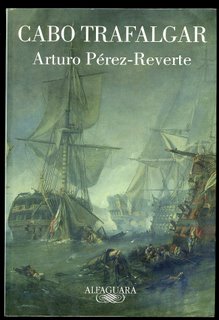 When Rebecca, Rosemary and I went to the National Gallery in Washington some 5 years ago I showed here a few paintings (not more than 10) One of them was Goyas's portrait of the Duke of Wellington. The other was David's magnificent portrait of Napoleon. I told her how one had vanquished the other. Unfortunately John Rigaud's fine portrait (the one on the cover of the Pocock biography) of aspirant (Nelson was 19 when the artist began it) Horatio Nelson was not in the Gallery and I could not tell her the little story so finely described in Pocock's book Horatio Nelson: 1805 During the coming month there were to be many meetings with ministers and senior officers in Whitehall and, before one with Lord Castlereagh, The Sectretary of State for War and the Colonies, a chance meeting and the conversation which followed illustrated Nelson's response to recognition. He found himself in an ante-room of the Colonial Office in Downing Street and sharing it with a major-general of authoritative and aristocratic manner, more than ten years his junior. The soldier was to recall how he had met there: ... a gentleman, whom from his likeness to his pictures and the loss of an arm, I immediately recognize as Lord Nelson. He could not know who I was, but he entered at once into a conversation with me, if I can call it a conversation, for it was almost all on his side and all about himself and, in reality, a style so vain and so silly as to surprise and almost disgust me. I suppose that something that I happened to say may have made him guess that I was somebody and he went out of the room for a moment. I have no doubt to ask the office-keeper who I was, for when he came back he was altogether a different man, both in manner and matter.Nelson had been told that his companion was Major-General Sir Arthur Wellesley, just returned from a succession of brilliant campaigns in India. Wellesley continued: All that I had thought a charlatan style had vanished and he talked of the state of the country and of the aspect and probabilities of affairs on the Continent with a good sense and a knowledge of subjects both at home and abroad that surprised me equally and more agreeably than the first part of our interview had done; in fact, he talked like an officer and a statesman.
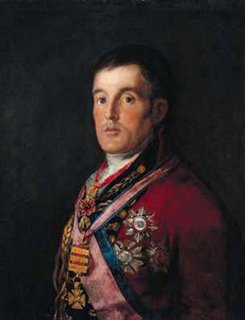
The Secretary of State kept us long waiting, and, certainly, for the last half or three-quarters of an hour, I don't know that I ever had a conversation that interested me more. Now if the Secretary of State had been punctual and admitted Lord Nelson in the first quarter of an hour, I should have had the same impression of a light and trivial character that other people have had, but luckily I saw enough to be satisfied that he was really a very superior man; but certainly a more sudden or complete metamorphosis I never saw. Horatio Nelson, Tom Pocock
Tuesday, January 29, 2008
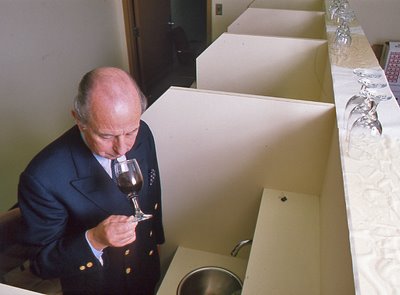 On April 13, 1997 a book review in the NY Times caught my eye. I cut it out. Six months later, on October 12, I snipped a NY Times last page Bookend called The History of the Historical Novel. A couple of years later I found a pocket book version of Andrew Miller's Ingenious Pain at the Granville Book Company. Soon after I saw a pristine (used) first edition hardcover and snapped it up (see below, right). This story of an 18th century surgeon, James Dyer, who is born without the "ability" to feel pain obsessed me to the point that I stayed up and read it in one night. Ingenious Pain is one of the most original period novels I have read and it compares most favourably with Daphne Du Maurier's House on the Strand. ...Where's your sense boy!'
James, figuring himself to be immensly high. immensly distant, finds it hard to believe they are pointing at him, waving too, sharp downward movements of their hands as though droving the air. He steps higher, to the V of two fragile branches. Their waving is more insistent. Joshua shouts like a distant cannon. James leans from the tree. The shouting stops. Even their hands freeze in front of them. He feels as if, stepping out, he will have no difficulty in flying. He stretches out his arms, gazes into the far ends of the afternoon. His weight passes a line, fine as a human hair, and then he is flying, amazingly fast into the green sky, and then nothing, nothing but the memory of flight, faint and fading, and the iron taste of blood in his mouth.Ingenious Pain, Andrew Miller 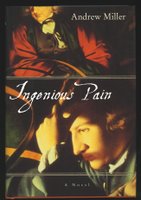 The book has been in my thoughts this last week. My terrible cold has persisted, past a second month and last week I was preparing myself a cup of tea. I was thinking of my very good Ahmad cardamom tea and when I opened the plain blue pottery container I could not smell anything. I went for the other blue container (Ahmad Earl Gray) and I smelled nothing. I asked Rosemary to tell me which one was which. Since last week I have not been able to smell or taste anything. I have been trying to enjoy my food using my memory and an awarenes of texture such as last night's melon with prociutto. Tea is warm and sweet. Prociutto partially salty and my extremely hot Macarico Piri Piri poured into scrambled eggs elicits not even a mild jolt in my mouth or anywhere else.  Surely taste and smell will come back! Surely Rebecca and I will be able to glory in the scent of Rosa'Fair Bianca' or our mystery peony! And what if our Magnolia grandiflora which has to yet bloom in our garden decides to do so this year? Will this most heavenly of scents be retrievable from my imagination? There is a saving grace, unlike poor surgeon James Dyer who feels no pain, I have, at least the potential for a memory of scent and taste. The pain of remebrance, will that be sufficient? Some years ago when my eldest daughter Ale started my filing system she filed the above gentleman sniffing the wine under Wine Sniffer. I took the shot so long ago Vancouver Magazine that I do not recall the gentleman's name. I am most sorry that both links to the book articles in the NY Times above might randomly demand access through free membership. The alternative is for me to cut and paste those articles (which I can readily see as I have both a paid, hard copy subscription and I am a member of the on line version) would get me into potential copyright problems.
A Cool Cat, A Dead Cat, The Shag Carpet & The Pool Party
Monday, January 28, 2008
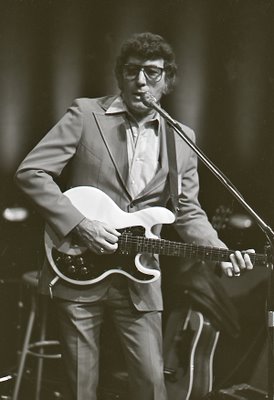
Sometime in 2002 I came home after a photo job and I heard Rosemary scream, "He's dead. He hasn't moved."
I had left Rosemary in bed watching TV an hour and a half before. Until then every time Rosemary had asked to have a TV by our bed I had always said,"It's either the TV or me." Fortunately for me she had chosen me every time. But Rosemary had had a foot operation and she was bed ridden for at least two weeks so we called the cable company and had an extension brought up to our bedroom. I had left her during the beginning of Hitchcock's Vertigo. Mosca, her dear black cat was lying on the foot of the bed.
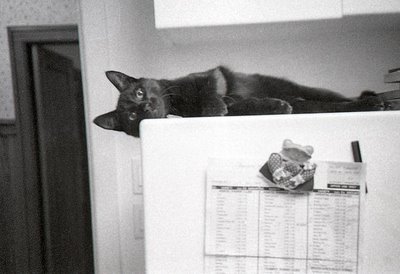
I nudged Mosca and he didn't move. I picked him up only to find out that rigor mortis had set in. He might have even died before I had left. The only cure to a dead cat, I soon found out, was an instant new one.
There is a randomness in today's blog that is not accidental. When weather is not good or I don't feel well I tend to try to file my stray negatives, transparencies and photographs that are in piles. One of the piles consists of pictures of people I don't remember or they are simply a symptom of the 35mm age when I shot several assignments (and even included personal shots) in one 36 exposure roll of film. I have been snipping them into order and then refiling them. In one negative sheet today I found three photos that had no relation to each other except I took all three around the same week sometime in the early 80s.
Mosca, our black cat on our fridge, happened, later, around 1986 when we had moved from Burnaby to Kerrisdale. Mosca was Rosemary's favourite cat and he was dear to her and he followed her everywhere. His coat was a slippery cool that made him a delight to hold. The negative appeared in roll that had pictures I took on a trip to the Seattle Art Museum.
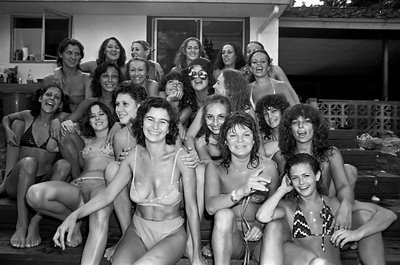
On the contact sheet of the three other photographs here I found an exposure of a stripper's pool party that I had been invited to attend. The cream of Vancouver's exotics was there. On the bottom right that's the legendary Little Mary. Behind Little Mary is another Vancouver legend, Jackie Coleman.
The man with the guitar is Carl Perkins who had come to Vancouver to appear in a CBC variety show. I was the stills photographer. And the last photograph is of Hilary in our Burnaby home's shag carpet. We hated the carpet. You could drop a quarter and lose it forever. Even worse, at the time Rosemary wore contact lenses and...It didn't help that the carpet was an uncool dirty green.
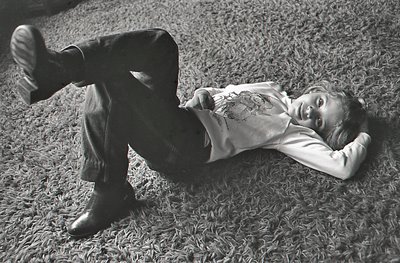
We have no more shag carpets. Hilary is now 34 and her daughters, Rebecca (10) and Lauren (5) put on white socks and slide with glee on our wooden living room floor. Toby the cat follows Rosemary everywhere and best of all we don't have a TV in our bedroom.
Ritter's Cove, The CBC Educates A Stills Photographer
Sunday, January 27, 2008
Ritter's Cove
Fri 8:00-8:30 p.m., 19 Sep 1980-20 Mar 1981 Wed 4:00-4:30 p.m., 14 Oct 1981-31 Mar 1982 (R) 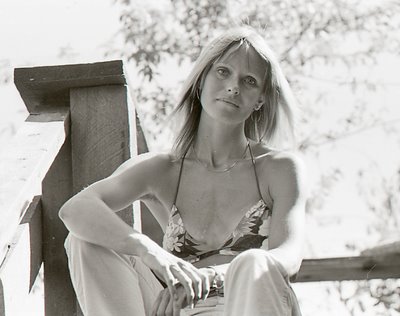 A co-production of the CBC, Taurus Films of Munich, and Global Television of London, Ritter's Cove was a family adventure series shot in British Columbia. Perceived as a successor to the network's long-running, west coast series, The Beachcombers, it was written by Lyal and Barbara Brown, who had contributed scripts to the earlier series. Hans Conninberg as Karl Ritter, an elderly pilot whose procrastination over a medical examination lost him his licence to fly. He was forced to hire Kate Ashcroft, played by Susan Hogan, as his replacement to keep his single airplane aloft and his transport business afloat. The stories generally revolved around the antagonism and mutual respect of the older man, set in his ways and his sexual stereotypes, and the younger, strong-willed woman. A co-production of the CBC, Taurus Films of Munich, and Global Television of London, Ritter's Cove was a family adventure series shot in British Columbia. Perceived as a successor to the network's long-running, west coast series, The Beachcombers, it was written by Lyal and Barbara Brown, who had contributed scripts to the earlier series. Hans Conninberg as Karl Ritter, an elderly pilot whose procrastination over a medical examination lost him his licence to fly. He was forced to hire Kate Ashcroft, played by Susan Hogan, as his replacement to keep his single airplane aloft and his transport business afloat. The stories generally revolved around the antagonism and mutual respect of the older man, set in his ways and his sexual stereotypes, and the younger, strong-willed woman.
Ritter's Cove was produced by David Pears, and the executive producer was Peter Kelly.In 1979 I was a veteran stills photographer who had shot 5 year's worth of CBC variety shows at the cavernous CBC on Hamilton Street. I was not prepared to shoot drama. By drama the CBC meant anything that was not a variety show that had song and dance numbers. I hated being called a stills photographers for several reasons. 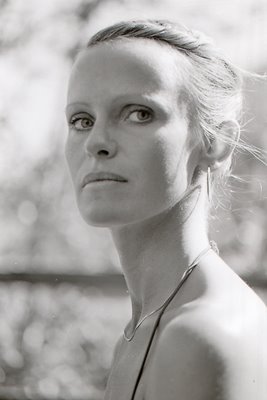 As a stills photographer I took pictures of the lead singers, dancers and hosts of the shows plus pictures of the sets for the set degigner as well as costume shots for the costumes department. But early on I was told that the floor sweepers who kept the floors clean and pristine for the dancers were far more important than I was. I was also told by the crane operator that if they ever had to stop a taping because I was in the line of the crane sweep they would probably not stop and just keep on going, with my inevitable demise. And if ever my cameras clicked and the sound engineers heard me, I would be packed and sent home to Burnaby where I lived at the time. 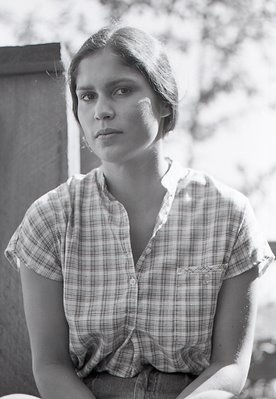 I resented the names "stills" photographer as I argued up an down that photographers were in existence quite a few years before movies came into the equation. I argued that film photographers should be called moving pictures photographers! But this was to no avail. After five years of this I was generally well liked. I minded my own business, they never heard any of my clicks, and I learned I had very good peripheral vision so a crane never had me in its way. 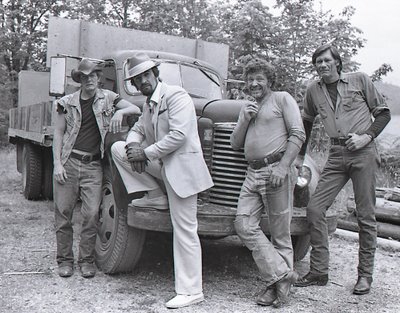 I was picked up by a Tyee Airways De Havilland Beaver (the very one that was used in the series I was to take pictures, Ritter's Cove) on Friday evenings and brought back, from Egmont, B.C. on Sunday for the duration of that 1979 summer. It was shooting this drama that I found out that unlike variety shows where they would use, simultaneously during a taping (video tape) perhaps two large cameras, a mobile one and a crane camera to get a variety of angles it was very different. In drama they used one film camera and would take several angles, one at a time. This meant that the actor or actors had to repeat their lines over and over not only for the important takes but also to takes from the side or from above. The camera operator was almost God and he (in Ritter's Cove it was a man seen here lying on his back but whose name I have forgotten) had a beautiful assistant camera operator. And cameramen who used film cameras (at the time they used an Arriflex) looked down on those who shot video in studios. 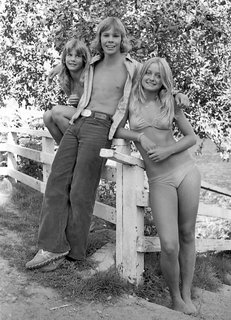 On my first trip to Egmont I was given a room in a hotel in Pender Harbour. I was given a particular room and I soon found out why. That first Friday evening I was not able to sleep. There was all sort of banging, creacking, gasping and screaming next door. I was asked with smiles the next day if I had slept well. I was then informed that Animal slept next door. Animal worked for staging and he was over-sexed. Nobody could figure out how he could work during the day and have sex all night. I was witness to this fact. Of the show I remember little except that the lead part was played by Susan Hogan who was beautiful and extremely gracious. The crew loved her. There was a young native Canadian woman who was striking and also approachable. The cameraman had a BMW motorcycle and on lunch breaks, he, his lovely assistant and I would hop on it and go skinny dipping in a nearby lake. We went without helmets as briefly that year someone had managed to block the enforcement of the helmet law. One of the young men working in lighting was Matthew 0'Connor (later like many at the CBC became pioneers in the Vancouver film industry). We loved his mother who was the caterer. This meant we had gourmet meals and freshly baked bread every day. One one day the show had lots of villains who posed for me by a truck. Another very popular guest of the show was Bantamweight boxer Dale Walters who won a bronze medal in the 1986 Olympics. He was very popular with the girls. I remember that he had a brand new Honda Accura with a sunroof. He took me for some rides in it. Most of us never appreciate how good things are when we have them and only miss them when we don't. That was not the case with me. I enjoyed every minute of it, every meal, every swim in the cold fresh water lake, every conversation I had with the crew, but most of all those landings in Vancouver's harbour in that Beaver in sunny summer evenings. I savoured them and I know remember them fondly. 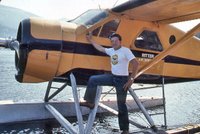 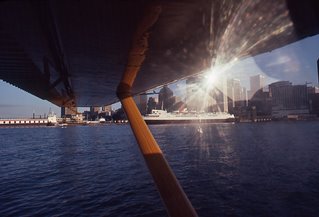
|







































